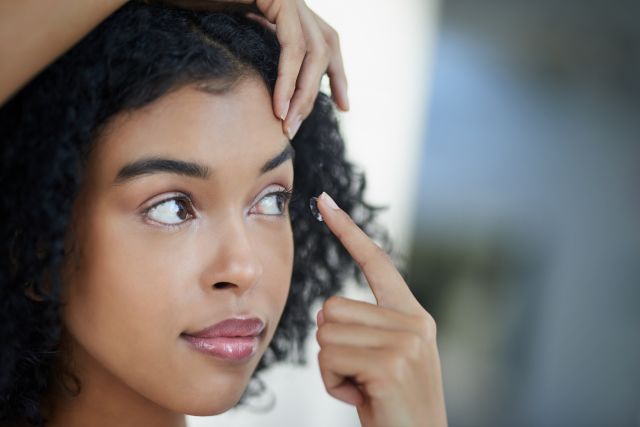It’s hard enough to brush your teeth, floss and wash your face before plopping under the covers. But if you’re one of the 41 million people in the US who wear contact lenses, you need to make time to remove them before hitting the hay. Improperly cleansing, storing and wearing contact lenses can lead to serious, painful eye infections. In fact, a 2015 Centers for Disease Control and Prevention (CDC) report found that 99 percent of those surveyed reported at least one risky behavior, including sleeping in contacts, not replacing the lens case as often as recommended, and adding new cleansing solution to old.
Some contacts are extended wear and made for overnight use. But you’ll even need an overnight break from those—at least one night with each time of scheduled removal. Some eye specialists like optometrist Katy Johnson, OD, of Fairview Park Hospital in Dublin, Georgia only prescribe daily wear contacts for their patients. “The CDC reported you are 15 to 20 times more likely to get an eye infection when sleeping in soft contact lenses compared to using contact lenses for daily wear only,” she says.
Risks of eye infection
If you leave your contact lenses in overnight even just once per week, you’re six and a half times more likely to develop keratitis, an inflammation of the cornea. One study found that one in five of those with keratitis infections had serious eye damage as a result of the condition. Microbial keratitis occurs when germs like viruses, bacteria, fungi or parasites enter the cornea when lenses are left in too long or when they’re not sanitized properly. Keratitis can also lead to corneal ulcers—open sores in the outer part of the eye.
If the infection is bacterial, Dr. Johnson says using anti-infective eye drops for one or two weeks should clear it up, but it’s likely you’ll need to miss work due to eye pain. “A fungal or parasitic infection can take up to 12 weeks to heal and the pain can be excruciating,” she says. Antibiotics, antifungal or antiviral eye drops are typically used for treating corneal ulcers. If symptoms such as pain and blurry vision continue after treatment with medication, surgery may be needed to retain your vision.
If you experience a feeling that something is in your eye, tearing, discharge, light sensitivity, itching, burning, redness, blurred vision, swelling or pain, remove your contacts as soon as possible and see your doctor. Bring your lenses with you since it can help determine what’s wrong.
How to prevent problems
Keeping your eyes in tip-tip shape requires some maintenance. Here are some ways to protect your peepers:
1. Get regular eye exams
“If a doctor is not regularly evaluating your eyes, you may have early signs of contact lens irritation and dryness without knowing it,” says Johnson. She says that proper fittings, accurate prescriptions and regular check-ups will keep your eyes in optimal shape.
2. Clean your lenses correctly
Your lens solution plays an important role in keeping your contacts clean. Use fresh lens solution each and every time you clean your contacts, and discard old cleanser after each use. Avoid rinsing contacts in any type of water (tap, distilled, bottled) or homemade saline solution, since those liquids can contain microorganisms that lead to eye infections.
3. Change your contact lens case regularly
Changing your lens case often will prevent bacteria from growing inside the case, transferring to your lenses and then to your eyes. “Patients often don't realize that a contact lens case over three months of age has a 40 percent risk of accumulating fungus growth, even if you rinse it out a few times,” says Johnson Remember that lens solution with hydrogen peroxide may have more specific instructions.
Johnson says contact lens cases are incredibly affordable, and many companies include one with your purchase of solution. “Replacing your cases quarterly cuts out a significant avenue for infection.”
What if you forget once?
Don’t stress if you wake up in the middle of the night and realize your contacts are still in. Take them out as soon as possible, and wear your glasses the next day to give your eyes a rest.





